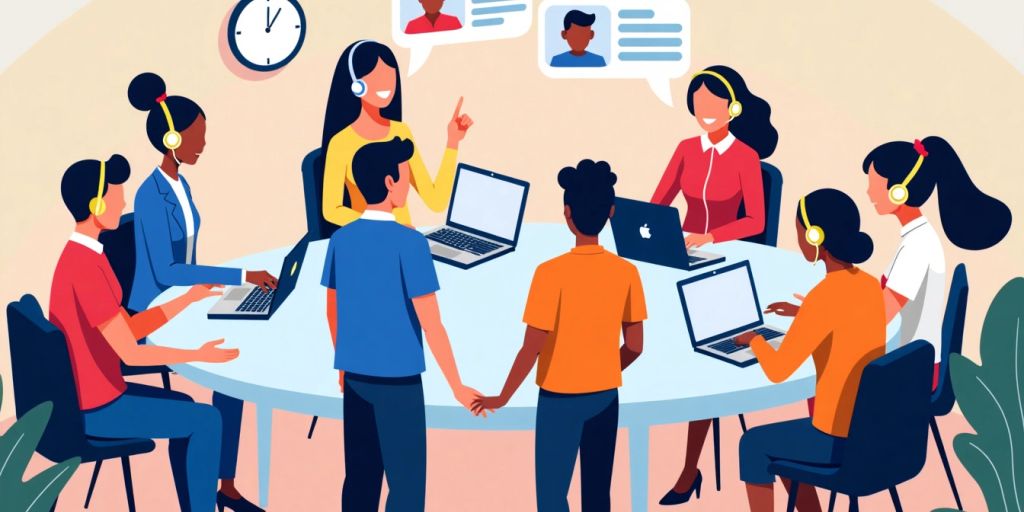In today’s fast-paced digital world, customer service chat agents play a crucial role in ensuring customer satisfaction. With the rise of online shopping and instant communication, these agents must develop a unique set of skills to effectively assist customers. This article explores essential skills, technology, best practices, training, success metrics, and future trends that can help chat agents excel in their roles.
Table of Contents
ToggleKey Takeaways
- Strong typing skills help agents respond quickly to customer inquiries.
- Using technology like AI chatbots can improve efficiency and customer satisfaction.
- Personalizing interactions makes customers feel valued and understood.
- Continuous training ensures agents stay updated on best practices and industry trends.
- Measuring success through customer feedback helps improve service quality.
Essential Skills for Customer Service Chat Agents

Effective Communication Techniques
To be successful, chat agents must master effective communication. This means they should be clear and concise in their messages. Here are some key points to remember:
- Use simple language that customers can easily understand.
- Avoid jargon unless necessary, and explain it if used.
- Always maintain a friendly tone to create a welcoming atmosphere.
Mastering Typing Speed and Accuracy
Good typing skills are essential for chat agents. They should aim for a typing speed of around 50-70 words per minute. This helps keep response times low, which is crucial since customers expect quick replies. Here are some tips:
- Practice typing regularly to improve speed.
- Use typing software to track progress.
- Familiarize yourself with keyboard shortcuts to save time.
Developing Empathy and Patience
Empathy is a vital skill for chat agents. They need to understand customers’ feelings and frustrations. Being patient is equally important, as some customers may be upset or confused. Here are ways to develop these skills:
- Listen actively to what the customer is saying.
- Acknowledge their feelings and reassure them.
- Take a moment to think before responding to ensure a thoughtful reply.
Problem-Solving and Resourcefulness
Chat agents often face unique challenges. They must be resourceful and willing to find solutions. Here are some strategies:
- Stay calm and focused when issues arise.
- Use available resources, like knowledge bases or colleagues, to find answers.
- Think creatively to resolve problems efficiently.
In the world of customer service, the ability to connect with customers can make all the difference.
By mastering these essential skills, chat agents can provide excellent service and create positive experiences for customers.
Leveraging Technology to Enhance Customer Service
In today’s digital age, technology plays a crucial role in improving customer service. Using the right tools can significantly boost efficiency and satisfaction. Here are some key strategies:
Utilizing AI Chatbots for Efficiency
- AI chatbots can handle routine inquiries, allowing human agents to focus on complex issues.
- They provide instant responses, which can enhance customer satisfaction.
- Chatbots can operate 24/7, ensuring support is always available.
Integrating Live Chat Solutions
- Live chat allows for real-time communication, making it easier to resolve issues quickly.
- It can be integrated into websites and apps, providing seamless support.
- Customers appreciate the ability to connect with a human when needed, fostering trust.
Implementing Analytics for Performance Improvement
- Analytics tools help track customer interactions and identify areas for improvement.
- They can measure response times and resolution rates, providing valuable insights.
- Regularly reviewing these metrics can lead to better service strategies.
Exploring Omnichannel Support
- Omnichannel support ensures customers can reach out through various platforms (e.g., social media, email, chat).
- This approach creates a consistent experience across all touchpoints.
- Companies like Nike have successfully implemented this strategy, enhancing customer satisfaction.
Technology is not just about automation; it’s about creating a better experience for customers. By leveraging these tools, businesses can build stronger relationships and improve overall service quality.
By embracing these technologies, businesses can not only enhance their customer service but also ensure they remain competitive in a rapidly changing market. Remember, the goal is to create a seamless experience that meets customer needs effectively. Effective customer conversations are key to achieving this success.
Best Practices for Managing Customer Interactions
Personalizing Customer Engagement
Creating a personal connection with customers is essential. Using their names and remembering past interactions can make them feel valued. Here are some ways to personalize engagement:
- Address customers by their names.
- Offer tailored recommendations based on previous purchases.
- Send personalized follow-up messages after interactions.
Handling Difficult Customers
Dealing with upset customers can be challenging, but it’s important to stay calm and professional. Here are steps to manage these situations:
- Listen actively to their concerns without interrupting.
- Show empathy by acknowledging their feelings.
- Offer a solution or escalate the issue if necessary.
Ensuring Data Privacy and Security
Customers need to trust that their information is safe. Here are some practices to ensure data privacy:
- Avoid asking for unnecessary personal information.
- Use secure systems to store customer data.
- Regularly update your privacy policies to reflect current practices.
Collecting and Acting on Customer Feedback
Feedback is crucial for improvement. Here’s how to effectively gather and use it:
- Use surveys after interactions to gather insights.
- Analyze feedback to identify common issues.
- Implement changes based on customer suggestions to enhance service.
Remember, good etiquette in technology is key to maintaining positive customer relationships. By following these best practices, chat agents can create a supportive and effective customer service experience.
Training and Development for Chat Agents
Onboarding New Agents Effectively
A strong onboarding process is crucial for new chat agents. Training should cover essential skills such as communication, typing speed, and product knowledge. Here are key steps to ensure effective onboarding:
- Provide comprehensive training materials.
- Pair new agents with experienced mentors.
- Conduct regular assessments to track progress.
Continuous Skill Development
To keep up with changing customer needs, ongoing training is essential. This can include:
- Workshops on new technologies.
- Role-playing scenarios to practice handling difficult situations.
- Access to online courses for skill enhancement.
Providing Regular Feedback and Coaching
Feedback is vital for growth. Managers should:
- Schedule regular one-on-one meetings.
- Use performance metrics to guide discussions.
- Encourage agents to share their experiences and challenges.
Encouraging Industry Expertise
Agents should be encouraged to develop industry knowledge. This can be achieved by:
- Attending industry conferences.
- Subscribing to relevant publications.
- Participating in online forums to exchange ideas.
Investing in training and development not only improves agent performance but also enhances overall customer satisfaction. A well-trained team can significantly impact customer loyalty and retention.
Measuring Success in Customer Service

Key Performance Indicators for Chat Agents
To effectively measure the success of customer service chat agents, businesses should focus on several key performance indicators (KPIs). These metrics help assess how well agents are performing and how satisfied customers are with their interactions. Here are some important KPIs:
- Customer Satisfaction Score (CSAT): This score reflects how happy customers are after their chat interactions. It’s usually gathered through a quick survey right after the chat ends.
- Net Promoter Score (NPS): This metric shows how likely customers are to recommend the service to others. It helps identify loyal customers versus those who might be unhappy.
- Customer Effort Score (CES): This score measures how easy or difficult it was for customers to get their issues resolved. A lower score indicates a smoother experience.
Customer Satisfaction Metrics
Understanding customer satisfaction is crucial for improving service. Here are some common methods to gauge satisfaction:
- Surveys: Quick feedback forms sent after interactions can provide immediate insights.
- Follow-Up Calls: Speaking directly with customers can uncover deeper insights into their experiences.
- Social Media Monitoring: Observing customer comments on social platforms can reveal public sentiment about the service.
Analyzing Response Times and Resolution Rates
Response times and resolution rates are vital for assessing efficiency. Here’s how to analyze them:
- Average Response Time: Measure how long it takes for agents to respond to customer inquiries.
- First Contact Resolution Rate: Track how many issues are resolved in the first interaction without needing follow-ups.
- Total Resolution Time: Calculate the average time taken to resolve customer issues from start to finish.
| Metric | Average Value |
|---|---|
| Average Response Time | 2 minutes |
| First Contact Resolution Rate | 85% |
| Total Resolution Time | 10 minutes |
Using Customer Reviews and Ratings
Customer reviews and ratings provide valuable insights into service quality. Here’s how to utilize them:
- Encourage Reviews: Ask satisfied customers to leave positive reviews online.
- Analyze Feedback: Regularly review comments to identify trends and areas for improvement.
- Act on Ratings: Use ratings to recognize high-performing agents and provide additional training where needed.
Measuring success in customer service is not just about numbers; it’s about understanding the customer experience and making improvements based on their feedback.
Future Trends in Customer Service
The Rise of Conversational AI
The use of conversational AI is growing rapidly in customer service. This technology allows businesses to provide instant responses to customer inquiries, improving overall satisfaction. Companies are now integrating AI chatbots to handle common questions, freeing up human agents for more complex issues.
The Importance of Accessibility
Accessibility is becoming a key focus in customer service. Businesses are working to ensure that all customers, including those with disabilities, can easily access support. This includes providing multiple channels for communication, such as text, voice, and video.
Adapting to Changing Customer Expectations
Customer expectations are evolving. Today’s consumers want quick, efficient service that fits their busy lives. Companies must adapt by offering flexible support options, including 24/7 availability and personalized interactions. Meeting these expectations is crucial for retaining customers.
Sustainability in Customer Service
Sustainability is increasingly important in customer service. Companies are looking for ways to reduce their environmental impact while still providing excellent service. This includes using digital tools to minimize paper waste and adopting eco-friendly practices in their operations.
As customer service continues to evolve, businesses must stay ahead of trends to remain competitive and meet the needs of their customers.
| Trend | Description |
|---|---|
| Conversational AI | Instant responses through AI chatbots for common inquiries. |
| Accessibility | Ensuring all customers can access support easily. |
| Changing Expectations | Adapting to the demand for quick and personalized service. |
| Sustainability | Implementing eco-friendly practices in customer service operations. |
As we look ahead, customer service is evolving rapidly. Businesses are now using smart tools like live chat to connect with customers anytime, day or night. This means faster answers and happier customers! If you want to see how this can work for you, check out our free live chat demo on our website!






